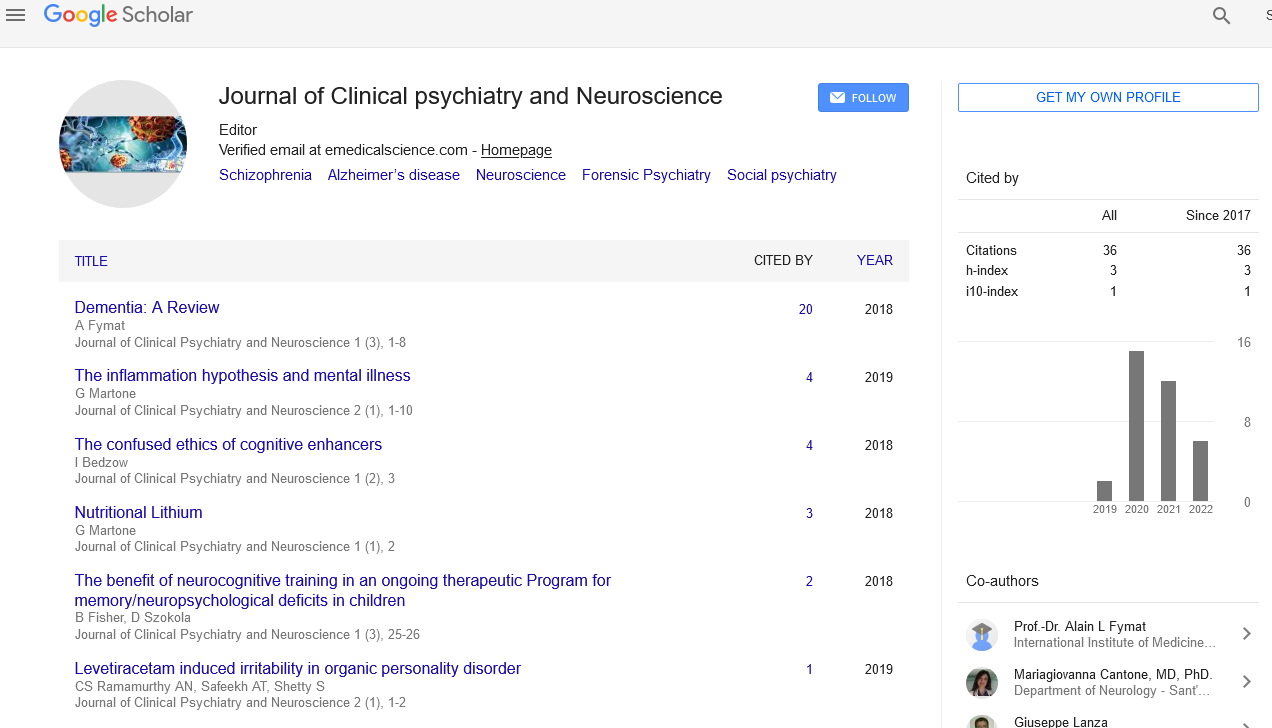Functional neurological disorder’s financial burden
Received: 07-May-2023, Manuscript No. puljcpn-23- 6583; Editor assigned: 09-May-2023, Pre QC No. puljcpn-23- 6583 (PQ); Accepted Date: May 26, 2023; Reviewed: 10-May-2023 QC No. puljcpn-23- 6583 (Q); Revised: 11-May-2023, Manuscript No. puljcpn-23- 6583 (R); Published: 27-May-2023, DOI: 10.37532/puljcpn.2023.6(3).112-13
Citation: Yeong G. Functional neurological disorder’s financial burden. J Clin Psychiatry Neurosci. 2023; 6(3):112-13.
This open-access article is distributed under the terms of the Creative Commons Attribution Non-Commercial License (CC BY-NC) (http://creativecommons.org/licenses/by-nc/4.0/), which permits reuse, distribution and reproduction of the article, provided that the original work is properly cited and the reuse is restricted to noncommercial purposes. For commercial reuse, contact reprints@pulsus.com
Abstract
Any nervous system disorder is a neurological disorder. A variety of symptoms can be caused by structural, metabolic, or electrical abnormalities in the brain, spinal cord, or other nerves. Paralysis, weak muscles, shaky coordination, loss of feeling, convulsions, confusion, pain, and altered degrees of consciousness are a few symptoms. There are numerous known neurological illnesses, some of which are rare but many of which are not. They may be examined neurologically, investigated, and treated within the fields of clinical neuropsychology and neurology.
Key Words
Neuropsychology; Neurology
Introduction
Preventive measures, lifestyle modifications, physiotherapy or other forms of therapy, neurorehabilitation, pain management techniques, medications, surgeries performed by neurosurgeons, and a particular diet are all examples of interventions for neurological illnesses. The World Health Organization estimated in 2006 that neurological disorders and the sequelae (direct consequences) they cause affect up to one billion people globally, and they identified social stigma and discrimination as well as health inequalities as the main causes of the resulting disability. Despite being protected by strong membranes, housed in the skull and spinal vertebrae, and chemically separated by the blood-brain barrier, the brain and spinal cord are extremely vulnerable if damaged. Although they frequently lay far beneath the epidermis, nerves are nonetheless susceptible to injury. Electrochemical and structural disturbance can affect individual neurons as well as the brain circuits and nerves they form. Although neurodegeneration is assumed to be uncommon in the brain and spinal cord, it may take place in the peripheral nervous system and help the body recover from or partially avoid traumas.
Despite the nervous system's normal fundamental structure, Functional Neurologic Disorder (FND) is characterized by genuine involuntary neurologic symptoms and signs like seizures, weakness, and sensory disturbance that have distinctive clinical features and pose a challenge to voluntary control and perception. The historical perception of FND as a diagnosis of exclusion might result in excessive use of medical resources and substantial direct and indirect costs to the economy. To determine these economic expenses and determine whether there are any treatments that are cost-effective, a systematic review was carried out following the preferred reporting items for systematic reviews and meta-analyses guidelines.
Functional Neurologic Disorders (FNDs) are real involuntary neurological symptoms and signs with distinctive clinical aspects that interfere with voluntary control and perception despite the nervous system's normal fundamental structure. FND can present with a variety of symptoms, such as aberrant movements, paralysis or weakness, sensory loss or odd sensory signs, swallowing or speech problems, and epileptic-like episodes (also known as Functional Seizures [FSs]). FNDs have a major influence on a patient's Quality Of Life (QoL), and patients frequently have co-occurring psychiatric disorders. Up to 40% of FND patients have both despair and anxiety. These expenses place a strain on the economy, the health care system, the professionals, and the patients. Patients with FND are, in fact, more likely than those with other neurologic illnesses to be unable to work due to health issues and to be receiving disability-related state financial benefits.
These symptoms and QoL can be improved with a variety of treatments, including physiotherapy and Cognitive Behavioral Therapy (CBT). Importantly, a simple intervention like giving the patient a proper diagnosis and an explanation of their symptoms can enhance their mood and quality of life while using fewer resources for their care.
There are direct and indirect costs associated with FND and other medical diseases. Indirect costs are productivity losses brought on by morbidity-related sickness absence (e.g., loss of employment, benefits, or cost of childcare while hospitalized), whereas direct costs are resources used for health care (e.g., cost of investigations or the time spent on assessment by a doctor). Through Cost-Of-Illness (COI) studies, the economic burden of FND can be calculated as the sum of its direct and indirect expenses. Either a top-down or bottom-up technique can be used in a COI study. Top-down approaches employ administrative registers of costs, whereas bottom-up approaches use data from records (or actual usage) at the service provider level to estimate costs.
Economic Evaluation (EE) is the main subject of other research of health care utilization. There are various EE kinds, including: Costminimization evaluations look at whether a particular solution would reduce the price of healthcare. In order to determine if an intervention is cost-effective, cost-effectiveness analyses integrate expenses with clinical indicators, such as gained life years or recovered cases. Quality-Adjusted Life Years (QALYs) are the effectiveness metric used in cost-utility assessments. QALYs make an effort to estimate how the patient's condition affects both the length and quality of life. The incremental cost-effectiveness ratio, a measurement of the additional cost per increased unit of health gained, is frequently used in cost-effectiveness evaluations. EE can help decision makers since it provides information beyond just the economic burden of a condition, which COI does not.





